CASE REPORT
NURSING CARE FOR PEOPLE WITH VENOUS
ULCER: CASE REPORT
ATENCIÓN DE ENFERMERÍA A
PERSONAS CON ÚLCERA VENOSA: REPORTE DE UN CASO
ASSISTÊNCIA DE ENFERMAGEM À PESSOA COM ÚLCERA VENOSA:
RELATO DE CASO
https://doi.org/10.31011/reaid-2023-v.97-n.1-art.1604
1Maria Karoline Santos Lima
2Hevillyn Cecília Ventura Barbosa Marinho
3José Arthur Guimarães dos Santos
4Kalyne Araújo Bezerra
5Kleyton Wesllen de Lima Ferreira
6Raissa Lima Coura Vasconcelos.
7Fabíola Moreira Casimiro de Oliveira
1Enfermeira.
Residente em Saúde da Família e Comunidade. Faculdade de Ciências Médicas da
Paraíba-FCMPB, João Pessoa, Brasil. ORCID – https://orcid.org/0000-0001-7177-8950
2Enfermeira. Residente em Saúde da Família e
Comunidade. Faculdade de Ciências Médicas da Paraíba - FCMPB, João Pessoa,
Brasil. ORCID – https://orcid.org/0000-0002-2299-9869
3Enfermeiro. Residente em Cardiologia.
Faculdade de Enfermagem Nova esperança, FACENE, João Pessoa, Brasil. ORCID - https://orcid.org/0000-0002-8451-8055
4Enfermeira. Mestranda em enfermagem.
Universidade Federal do Rio Grande do Norte (UFRN). Natal, Rio Grande do Norte,
Brasil. ORCID: https://orcid.org/0000-0001-8108-9980
5Enfermeiro. Residente em Pediatria. Escola de
Saúde Pública – ESP-PB, João Pessoa, Brasil. ORCID - https://orcid.org/0000-0002-3314-9560
6Enfermeira. Pós-graduada em Dermatologia,
Residente em Saúde da Família e Comunidade. Faculdade de Ciências Médicas da
Paraíba, João Pessoa, Brasil. ORCID - https://orcid.org/0000-0001-6249-1894
7Enfermeira. Mestre em enfermagem. Universidade
Federal da Paraíba, João Pessoa, Brasil. ORCID – https://orcid.org/0000-0003-2983-6621
Corresponding
Autho
Maria Karoline Santos Lima
Rua: Risoldo Ferreira de Lima Rizzo -139 - Planalto Boa Esperança. João Pessoa –
PB. Brasil. CEP: 58065137.
Contato: +55(83) 98845-4403. E-mail: karolinelimaenf@gmail.com
Submission:
08-12-2022
Approval: 27-12-2022
ABSTRACT
Objective: To report nursing care to patients with venous ulcers
and the impact on the user's quality of life. Methodology: This is a
qualitative study of the case report type with a qualitative design, following
the checklist of the Case Report Guidelines (CARE) of the EQUATOR Network. Results:
In this study, it was possible to observe the healing evolution of a venous
ulcer located in the right lower limb, the periodic evaluations under
photographic record and therapeutic adherence adopted in each procedural step
for better understanding and integral evaluation of the user. Conclusions: Thus,
upon completing the treatment and follow-up with the user, it was noticed that
he presented a significant improvement in his quality of life, improving his
social and family life, in addition to a better perception of his self-esteem
and self-image.
Keywords: Case reports; Venous Ulcer; wound Healing; Nursing
Assistance.
RESUMEN
Objetivo: Relatar los cuidados de enfermería a pacientes con
úlceras venosas y el impacto en la calidad de vida del usuario. Metodología:
Se trata de un estudio cualitativo del tipo reporte de caso con diseño
cualitativo, siguiendo la lista de verificación de las Directrices de Reporte
de Casos (CARE) de la Red EQUATOR. Resultados: En el presente estudio
fue posible observar la evolución de la cicatrización de una úlcera venosa
localizada en miembro inferior derecho, las evaluaciones periódicas bajo
registro fotográfico y la adherencia terapéutica adoptada en cada paso del
procedimiento para una mejor comprensión y evaluación integral del usuario. Conclusiones:
Así, al finalizar el tratamiento y seguimiento con el usuario, se percibió
que presentaba una mejora significativa en su calidad de vida, mejorando su
convivencia social y familiar, además de una mejor percepción de su autoestima
y Auto imagen.
Palabras clave: Informes de Casos; Úlcera Venosa; Cicatrización de la
Herida; Asistencia de Enfermería.
RESUMO
Objetivo: Relatar a assistência de enfermagem ao paciente com
úlcera venosa e o impacto na qualidade de vida do usuário. Metodologia: Trata-se
de um estudo qualitativo do tipo relato de caso com delineamento qualitativo,
seguindo a lista de verificação da Case Report Guidelines (CARE) da EQUATOR
Network. Resultados: No presente estudo foi possível observar a evolução
cicatricial de uma úlcera venosa localizada no membro inferior direito, às
avaliações periódicas sob registro fotográfico e adesão terapêutica adotada em
cada etapa processual para melhor compreensão e avaliação integral do usuário. Conclusões:
Assim, ao concluir o tratamento e acompanhamento com o usuário percebeu-se
que, o mesmo apresentou melhora significativa da sua qualidade de vida,
melhorando o seu convívio social e familiar, além de melhor percepção sob sua
autoestima e autoimagem.
Palavras-chave: Relatos de Casos; Úlcera Venosa; Cicatrização de Feridas;
Assistência de Enfermagem.
INTRODUCTION
Chronic venous ulcer is considered the most common among
other wound etiologies, being considered a public health problem due to its
complexity and chronicity. Venous ulcers are characterized as a result of
valvular incompetence associated or not with venous flow obstruction, they are
lesions that have the healing process stagnated for six weeks or more, these
wounds have a long duration, are recurrent and for having slow healing, in
months or years, leads to damage to the quality of life of the patient and
causes high costs for treatment (1).
Venous ulcers affect approximately 1 to 2% of the world's
population and, in Brazil, they represent the 14th cause of temporary absence
from work and the 4th greatest cause of definitive absence from work, since
about 70 to 90% of varicose ulcers affect the lower limbs (1).
Given the above, the impacts generated by venous ulcers
are not only linked to the economic factor, but also to the physical and
psychosocial aspects. There are many negative consequences generated by the
lesion, such as difficulty in socializing, depression problems, anxiety, anger,
shame, interfering with the state of balance, self-image, self-esteem,
self-care, and consequently the Quality of Life (QL) of the individual and his
family, which is a relevant phenomenon for health care (2).
The frailty of the individual with chronic wounds
is a predominant trend in these cases, therefore, emotional support should be
considered a priority, favoring autonomy in making decisions about the problems
triggered by the injury. However, the impact on the QL of people with wounds is
not always easy to measure by health professionals, which generates greater
complexity and hinders the care provided (2, 3).
In this sense, health professionals play a key role in
assisting a person with a chronic venous ulcer, since they work to reduce the
impacts that the disease imposes on the affected person, as well as in the
search for health promotion and disease development prevention (3).
It is noteworthy that the role of nurses in caring for
people with wounds is regulated by the resolution of the Federal Council of
Nursing (COFEN) No. 0567/2018, which provides for the role of the nursing team
in the care of patients with wounds (4). Therefore, the nurse is
responsible for autonomy and responsibility in all decision-making, as well
as, agreement with the multidisciplinary team in monitoring during the
whole process of care provided to the person with a wound (1).
It is essential to emphasize the importance of
nurses in the care of people with wounds, however, often the care is based on
weak evidence that does not meet the information and conduct accurately and
scientifically validated. The products on the market have been innovating and
developing, seeking effectiveness in the treatment of wounds, which requires
technical and scientific training for nurses to better evaluate and guide the
care plan consistently with the current situation of the user. (5).
Given the considerations mentioned above, the question
is: How is the nurse's assistance performed to a chronic venous ulcer carrier,
and what is the importance of the nurse's qualification in wound healing? What
are the impacts that the chronic wound caused on the quality of life of the
user of this study? This study has a general objective: to report the nursing
care provided to patients with venous ulcers and the impact on the user's
quality of life.
METHODS
This is a qualitative case report study with a qualitative
design, following the EQUATOR Network Case Report Guidelines (CARE) checklist(6).
Case reports describe a situation in order to understand and interpret the
different phases of the case (7).
The study was developed from a case of chronic venous
ulcer in a user belonging to the Health District (HD) IV, in the municipality of
João Pessoa, in the state of Paraíba. Data collection was performed through
photographic records recorded on a single cell phone during the whole process
of lesion monitoring aiming to analyze the evolution of the wound, plus
information contained in the family medical record, specifically the forms used
in nursing care.
In addition, a structured questionnaire prepared by the
researchers was applied in order to collect socioeconomic information, namely:
gender, age, color/race, marital status, religion, education, profession,
occupation, retirement, family income, who lives with, children, use of
medications, diagnosis of hypertension, diabetes or some other pathology.
To complement the data collected, a survey of articles
was carried out through the review method about chronic venous ulcers and the
role of nursing professionals in the care of people with wounds, conducted by
the authors, performed searches in databases and virtual libraries, such as
Scielo, Lilacs, Medline, Pubmed, Cinahl, among others.
This research offered predictable risks, however minimal,
that are related to physical, mental, and/or spiritual discomfort which can be
mentioned embarrassment and/or sadness by raising unpleasant memories about the
physical suffering before the clinical case. To minimize and/or avoid such
risks, the researcher maintained privacy, discretion, respect, and emotional
support during all the stages of the study, respecting the participant's will
and desire to remain or give up their participation at any time during the
study.
It is noteworthy that this study met the ethical
precepts, meeting the resolution No. 466/2012, of the National Health Council
CNS/MS/BRASIL and the principles evoked by the Code of Ethics of Nursing Professionals
- Resolution of the Federal Council of Nursing - COFEN No. 564/2017 regarding
confidentiality, privacy, and consent of the participant.
The report was reviewed by the Ethics Committee of the
Faculdade de Ciências Médicas da Paraíba/ FCMPB under CAAE:
60807922.6.0000.5178 and approved by opinion number 5.617.081.
RESULTS
Patient,
A.B.S., male, 72 years old, living in the city of João Pessoa in the state of
Paraíba, father of a 40-year-old daughter, divorced, living with his current
partner. He is a bricklayer and carpenter but currently works repairing
bicycles. He has incomplete elementary school education, is retired, with a
family monthly income of one minimum wage, self-declared white, and follows the
Catholic religion. He denies alcoholism and smoking.
As comorbidities, he has Systemic Arterial Hypertension
(SAH) and Type II Diabetes Mellitus, both pathologies discovered by the user
approximately 15 years ago. He takes Losartan 50mg and Captopril 25mg, as well
as NPH insulin.
The
user seeks the family health unit complaining of pain in the right lower limb
and difficulty walking due to a lesion in the limb that had remained open for
over four years. He claims to have initially arisen from a rejection of the plate
placed on the limb after a car accident, having undergone several topical
treatments, analgesic medications, and antibiotics, but without success. At the
first evaluation, he was anxious, apprehensive, and collaborative, with a face
of pain, but eupneic, hypotensive, and afebrile and had normal heartbeat rate
and color.
Figure
1 -
Chronic venous ulcer at first evaluation, presence of sphacel in the bed,
hyperemia, and edema in the limb with a culture of the lesion which resulted in
Pseudomonas Aeruginosa.
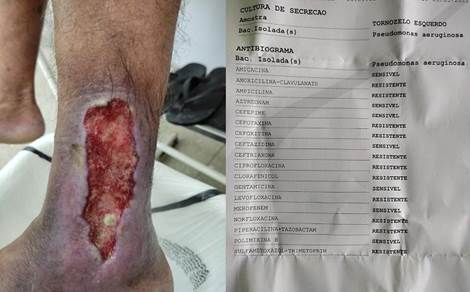
Source: Author's personal file, 2022
Lesion located in the right lower limb (RLL),
approximately 15cm in diameter, with presence of pulse in the area of the
tibia, posterior and pedial, signs of inflammation (pain, redness, heat, edema,
hyperemia), perilesional skin presenting ochre dermatitis, irregular and
macerated edges. The bed of the lesion has sphacelus and granulation tissue,
high exudate of greenish-yellow color with the presence of a characteristic
odor.
After the initial evaluation of the lesion, wound
cleaning was performed according to the following steps: cleaning with saline
0.9%, antiseptic soap with polyhexanide (PHMB), application of primary dressing
with calcium alginate and sterile gauze, and as secondary layer compressive
therapy with a bandage was used.
The
user was instructed to rest and elevate the limb for at least 40 minutes a day
to reduce edema, increase fluid intake, and eat adequate and necessary food to
aid healing, as well as requesting bacteriological culture of the lesion,
pressure mapping, and daily assessment of fasting blood glucose by capillary
test for monitoring
The evaluation of the multi-professional team was also
requested, which included: a doctor, nutritionists, a pharmacist, and a physiotherapist.
The user's diet, body mass index, administration of oral and injectable
medications, and the performance of kinetic postural assessments were performed
for better understanding, and comprehensive evaluation of the user aiming at
reducing factors that delay healing.
Chart 1 - Evolution
of the Chronic Venous Ulcer, cleaning of the lesion, bandage used.
|
IMAGE
|
LESION
|
DATE
|
CLEANING
|
COVERAGE
|
|
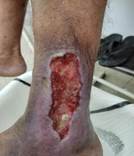
|
- Phlogistic signs
- Smears
- Maceration of edges
- Ochre dermatitis
- Granulation tissue
- High exudate
|
02.08.2022
|
SS 0.9% +
antiseptic soap with PHMB
|
Barrier
cream (perilymph) + calcium alginate tape + sterile gauze + bandage
|
|
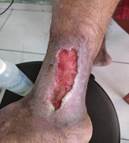
|
- Phlogistic signs
- Ochre dermatitis
- Maceration of the borders
- Granulation tissue
- High exudate
-
Pseudomonas aeruginosa
|
02.22.22
|
SS 0.9% + antiseptic soap with PHMB
|
Barrier
cream (perilymph) + calcium alginate tape + sterile gauze + bandage
|
|
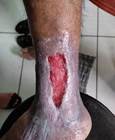
|
- Ochre Dermatitis
- Maceration of the edges
- Granulation tissue
- High exudate
|
03.24.2022
|
SS 0.9% + antiseptic soap with PHMB
|
Barrier
cream (perilymph) + calcium alginate tape + sterile gauze + bandage
|
|
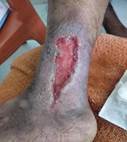
|
- Ochre
Dermatitis
-
Maceration of the edges
-
Granulation tissue
- High
exudate
-
Acinobacter spp bacteria
|
04.01.22
|
SS 0.9% + antiseptic soap with PHMB
|
Barrier cream (perilymph) +
calcium alginate tape + sterile gauze + compressive therapy with bandage
|
|
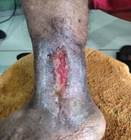
|
- Ochre
Dermatitis
-
Approximation of the borders
-
Increased tissue in the lesion bed
-
Granulation tissue
- Smears
- Low
exudate
|
04.25.22
|
SS 0.9% + antiseptic soap with PHMB
|
Barrier
cream (perihelion) + hyaluronic acid + gauze with PHMB (Kerlix™)+ Unna boot
|
|
|
- Ochre
Dermatitis
-
Granulation Tissue
|
06.05.2022
|
SS 0.9% +
|
Barrier cream (perihelion)
+ hyaluronic acid +
|
|
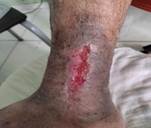
|
-
Approximation of the borders
- Increased
tissue in the bed
- Low
exudate
|
|
antiseptic soap with PHMB
|
gaze com
PHMB
(Kerlix™)+
compressive therapy with bandage
|
|
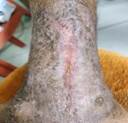
|
- Ochre
Dermatitis
-
Epithelialization tissue
-
Approximation of borders
- Flat
wound
- No
exudate
|
06.06.2022
|
SS 0.9% + antiseptic soap with PHMB
|
Barrier
cream (perihelion) + hyaluronic acid + gauze with PHMB (Kerlix™)+ compressive
therapy with bandage
|
|
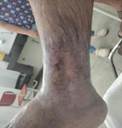
|
- Flat wound
- No exudate
- No phlogistic signs
- 100% healed
|
07.06.2022
|
SS 0.9% + antiseptic soap with PHMB
|
Barrier cream
|
|
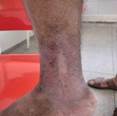
|
- 100%
healed
- Given
guidelines on skin maintenance.
|
07.15. 2022
|
|
Barrier cream
|
Acronyms: SS: saline solution; PHMB:
polyhexamethylene-biguanide.
Source: Author's personal file, 2022.
DISCUSSION
Most of the people affected by venous ulcers are
male. It was also observed that people over 50 years of age, of both sexes, who
have low education and an income equal to or less than one minimum wage are
more likely to develop ulcers (8). The increase in cases of venous ulcers is
related to the incidence of comorbidities (Systemic Arterial Hypertension
(SAH), Diabetes Mellitus (DM), venous insufficiency, and overweight or obesity)
in people over 60 years old, as is the case in the study user, who has SAH,
type 2 DM, venous insufficiency, is overweight, and is 72 years old. (9-10).
When evaluating the user's injury, one can observe
characteristics of Chronic Venous Insufficiency (CVI), highlighting skin
hyperpigmentation, edema, and pain, among others, the observation of these
signs being essential for a better decision of therapeutic measures (9).
Most of the time, ulcers get healed over a long period,
and it can be even longer when an infectious process occurs because it is
associated with an increase in the healing period of the wound. Infections in
leg ulcers are caused by Gram-positive and Gram-negative bacteria, often
resulting in the need for hospitalization.
The most common bacteria in wounds are Staphylococcus aureus,
Pseudomonas aeruginosa, Enterococcus faecalis, Klebsiella pneumoniae and
Escherichia coli, which, despite being common, are difficult to treat, because
when they develop they are resistant to one or more antibiotics, becoming a
challenge for assistance and prolonging hospitalization. (11)
The culture for identification of microbial isolates
becomes extremely necessary since it enables nurses to have a more critical
view of chronic wounds, showing the possibility of bacterial resistance, which
can cause increased treatment time and institutional costs. In this sense,
three techniques that are considered efficient in bacterial identification
stand out, biopsy, needle aspiration, and swab; the latter is practical,
economical, non-invasive, and guides antibiotic therapy and subsidizes
sensitivity tests (11).
In this sense, it is necessary a systematic and
structured assessment of the wound bed, identifying factors that may hinder
healing. Therefore, we created the mnemonic rule using the acronym TIME, where
the T stands for the presence or absence of devitalized tissue; the letter I
stands for the presence of infection or colonization; the letter M stands for
moisture imbalance; and the letter E refers to the "edge", evaluation
of the wound border. After that, the next steps follow: the process of cleaning
the lesion and proper coverage to achieve the desired results (12).
Faced with the variety of products with antiseptic action,
it is recommended to search for those with non-toxic actions that can
effectively control the bacterial load, reduce biofilm and promote chronic
wound healing. Currently, polyhexamethylene-biguanide (PHMB) stands out in the
market, which has antiseptic properties acting on cell disruption in gram
negative, gram positive, and anaerobic bacteria and in plaque and biofilm
formation, being lethal for a wide spectrum of bacteria and has low toxicity
for human cells. (12-13).
In clinical practice, among the best-known dressings
are alginate-based bandages, which may present several formats of plaques, such
as flat and porous, freeze-dried, tape, and string, designed for cavitary
wounds. Calcium alginate, or sodium calcium alginate, is derived from brown
seaweed, and its main characteristics are absorption of wound exudate with
moderate or high exudate, ability to keep the wound bed moist, promote
autolytic debridement, hemostasis due to calcium ions, and help contain
bleeding (11).
Another product that has been widely studied and
that was used in the case reported is hyaluronic acid, a high molecular weight
polysaccharide that offers support, volume, hydration, and tissue elasticity
and is present in the connective tissue of the dermis. Its use in wounds is
effective because it has a high capacity to retain water, promotes a humid
environment suitable for the synthesis of collagen and elastin, favors healing,
has an antioxidant, and anti-inflammatory effect, and acts against free
radicals, protecting the skin (13).
A treatment option in cases of venous ulcer is
compressive therapies, which could be elastic (stockings, bandages, or
multi-layers), inelastic (unna boot), or intermittent pneumatic. The boot
stands out for its high effectiveness in the treatment of venous ulcers,
allowing compression on the affected limb, which facilitates blood return and
promotes therapeutic effects due to its composition (14).
This technique was developed in 1896 by the
German dermatologist Paul Gerson Unna, and has proven efficient in the
treatment of venous ulcers and lymphatic edema. It can be performed by the
physician or nurse, and the exchange varies from 3 to 7 days depending on the
amount of exudate in the lesion (15). The nurse should be aware of
the intensity that will be exerted during the performance of the technique,
since it may cause limb tourniquetting and ineffective pressure due to
loosening of the bandage, triggering ineffectiveness of treatment (14).
Therefore, the diagnosis and treatment of chronic
and infected venous ulcers becomes a challenge for the multidisciplinary team.
The team, through clear symptom criteria, and holistic assessment is able to
implement timely assistance that offers adequate treatment (11).
FINAL
CONSIDERATIONS
Considering the observed aspects, it is
perceptible the relevance and importance of Nursing regarding the patient's
healing process. Nurses are responsible for assisting the individual as a
whole, taking into account their weaknesses, whether physical or emotional. In
addition, they treat venous ulcers, monitor their evolution, adopt strategies
to promote the healing of lesions already installed, and prevent other injuries
and relapses, aiming to reduce the discomfort and pain of patients.
Thus, at the end of the treatment and follow-up
with the user of this study, it is clear that he presented a significant
improvement in his quality of life, improving his social and family life. His
self-esteem and self-image were also positively impacted, allowing him to be
perceived as an active person in society, putting an end to the cycle of the
injury that can last for decades and that directly affects the mental health of
the patients.
REFERENCES
1.
Cordeiro JPN, Almeida EIA,
Magalhães AKG, Galvão AMN, Carvalho HB, Pitta GBB. Treatment of varicose ulcer
with unna boot: Adverse effects arising from lack of knowledge in its
maintenance. RSD [Internet]. 2022 [cited 2022 Nov 28];11(5):e37011527584. doi: https://doi.org/10.33448/rsd-v11i5.27584
2.
Silva TG, Vasconcelos APL,
Ramos EVC, Farias Neto JP.Evaluation of the quality of life of patients with
chronic wounds treated at the healing clinic of the University Hospital of
Sergipe. Sergipe: Rev Bras Qual Vida. 2017;9(3):234-246. doi: https://doi.org/10.3895/rbqv.v9n3.6704
3.
Ascari RA, Müller GV,
Carvalho AS, Weihermann AMC.Venous ulcers and the changes caused in the family
structure. Rev Enferm Atual In Derme. 2022;96(37):e-021192.doi: https://doi.org/10.31011/reaid-2022-v.96-n.37-art.1278
4.
Conselho Federal de
Enfermagem [Internet]. Resolução COFEN nº 567, de 04 de fevereiro de 2018.
Brasília: COFEN; 2018. [citado 2022 Nov 29]. Disponível em: http://www.cofen.gov.br/resolucao-cofenno-567-2018_60340.html.
5.
Costa JAS, Pitella CQP,
Lopes APR, Caetano LCO, santos KB. Nursing knowledge in chronic wound
management in primary health care settings. Rev Enferm Atual In Derme.
2022;96(37):e-021199. doi: https://doi.org/10.31011/reaid-2022-v.96-n.37-art.1282
6.
Riley DS, Barber MS,
Kienle GS, Aronson JK, Von Schoen-Angerer T, Tugwell P, et al. CARE guidelines
for case reports: explanation and elaboration document. J Clin Epidemiol.
2017;89:218-35. doi: https://doi.org/10.1016/j.jclinepi.2017.04.026
7.
Casarin ST, Porto AR.
Experience Report and Case Study: some considerations. J. nurs. health
[Internet]. 2021 [citado nov 29];11(2):e2111221998. Disponível em: https://periodicos.ufpel.edu.br/ojs2/index.php/enfermagem/article/view/21998
8.
Santos FVM, Chagas MPL,
Chaves RN. Sociodemographic and Epidemiological Profile of Patients Treated
with Unna Boot. Rev Saúde. 2020; 7(2):25-40. doi:
http://dx.doi.org/10.12819/rsf.2020.7.2.2
9.
Bernardino LCS, Santos
INB, Estrela FM, Soares CFS, Bina GM, Reis RP, et al. Evolution of pressure
injury associated with conservative instrumental breakdown by nurses in primary
health care. Rev Enferm Atual In Derme. 2021;95(34):e-021092. doi: https://doi.org/10.31011/reaid-2021-v.95-n.34-art.1095
10.
Fadel ARMC. Caracterização
do perfil epidemiológico e demográfico de pacientes com Lesões de membros
inferiores: estudo de prevalência em um hospital privado de Minas Gerais. Minas
Gerais. monografia (Especialização em Enfermagem) - Universidade Federal de
Minas Gerais; 2020.
11.
Garcia TF, Silva PGA,
Barcelos BJ, Miranda MGR, Alonso CS, Abreu MNS, et al. Criteria to evaluate the
quality of alginate wound dressings. Rev Bras Enfermagem. 2021;74(4):e20201091.
doi: https://doi.org/10.1590/0034-7167-2020-1091
12.
Santos MC. Efetividade do
polihexametileno-biguanida (PHMB) na redução do biofilme em feridas crônicas:
revisão sistemática. Paraná. dissertação (Mestrado em Enfermagem) -
Universidade Federal do Paraná; 2017.
13.
Silva APR, Silva JC,
Campos RMB, Abreu AM. The use of Hyaluronic Acid for wound healing: integrative
literature review. RSD. 2022;11(5):e58711528581. doi: https://doi.org/10.33448/rsd-v11i5.28581
14.
Motta ALC, Oliveira EC,
Silva GC. The role of nursing in the application of Unna Boots for treatment of
venous injuries. Brazilian Journal of Development. 2022;8(9):61671-9. doi:
10.34117/bjdv8n9-084
15.
Cardoso LV, Godoy JMP,
Godoy MFG, Czorny RCN. Compression therapy: Unna boot applied to venous
injuries: an integrative review of the literature. Rev Esc Enferm USP.
2018;52:e03394. doi: http://dx.doi.org/10.1590/S1980-220X2017047503394
Fomentation: there
is no development institution
Scientific Editor: Francisco Mayron Morais Soares. Orcid:
https://orcid.org/0000-0001-7316-2519